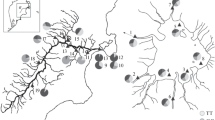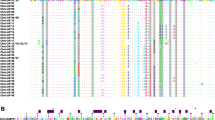Abstract
Allelic variation in the major histocompatibility class (MHC) IIB gene of salmonids is analyzed for patterns indicative of natural selection acting at the molecular level. Sequence data for the second exon of this MHC gene were generated for 11 species in three salmonid genera: Oncorhynchus, Salmo, and Salvelinus. Phylogenetic analysis of nucleotide sequences revealed: (1) monophyletic grouping of alleles from each genus, (2) transspecies evolution of alleles within Salmo and Salvelinus, and (3) differential patterns of transspecies evolution within the genus Oncorhynchus. Within Oncorhynchus, five of seven species had alleles that were species-specific or nearly so, while the remaining two, O. mykiss and O. clarkii, retained ancestral polymorphisms. The different patterns in Oncorhynchus and the other two genera could be due to historical demographic effects or functional differences in MHC molecules in the three genera, but the two hypotheses could not be distinguished with the current dataset. An analysis of recombination/gene conversion identified numerous recombinant alleles, which is consistent with what has been found in other vertebrate taxa. However, these gene conversion events could not account for the species-specific allelic lineages observed in five of the Oncorhynchus species. Analyses of the relative rates of nonsynonymous and synonymous substitutions revealed the signature of selection on the class IIB gene in all 11 of the salmonid species for both the ABS and the non-ABS codons. Codon-based analyses of selection identified seven codons that have experienced selection in the majority of the species. More than half of these sites were mammalian ABS codons, but several were not, suggesting subtle functional differences in the mammalian and teleost fish MHC molecules.




Similar content being viewed by others
References
Aguilar A, Garza JC (2006) A comparison of variability and population structure for major histocompatibility complex and microsatellite loci in California coastal steelhead (Oncorhynchus mykiss Walbaum). Mol Ecol 15:923–937
Alledorf FW, Leary RF (1988) Hybridization dynamics between sympatric species of trout: loss of reproductive isolation. Conserv Biol 2:170–184
Anisimova M, Nielsen R, Yang ZH (2003) Effect of recombination on the accuracy of the likelihood method for detecting positive selection at amino acid sites. Genetics 164:1229–1236
Apanius V, Penn D, Slev PR, Ruff LR, Potts WK (1997) The nature of selection on the major histocompatibility complex. Crit Rev Immunol 17:179–224
Baumsteiger J, Hankin D, Loudenslager EJ (2005) Genetic analyses of juvenile steelhead, coastal cutthroat trout, and their hybrids differ substantially from field identifications. Trans Am Fish Soc 134:829–840
Bergstrom TF, Josefsson A, Erlich HA, Gyllensten U (1998) Recent origin of HLA-DRB1 alleles and implications for human evolution. Nature Genet 18:237–242
Bettles CM, Docker MF, Dufour B, Heath DD (2005) Hybridization dynamics between sympatric species of trout: loss of reproductive isolation. J Evol Biol 18:1220–1233
BingulacPopovic J, Figueroa F, Sato A, Talbot WS, Johnson SL, Gates M, Postlethwait JH, Klein J (1997) Mapping of MHC class I and class II regions to different linkage groups in the zebrafish, Danio rerio. Immunogenetics 46:129–134
Brown JH, Jardetzky TS, Gorga JC, Stern LJ, Urban RG, Strominger JL, Wiley DC (1993) Three-dimensional structure of the human class-II histocompatibility antigen HLA-DR1. Nature 364:33–39
Crespi BJ, Fulton MJ (2004) Molecular systematics of Salmonidae: combined nuclear data yields a robust phylogeny. Mol Phylogenet Evol 31:658–679
Cummings MP, Otto SP, Wakeley J (1995) Sampling properties of DNA-sequence data in phylogenetic analysis. Mol Biol Evol 12:814–822
Dorschner MO, Duris T, Bronte CR, Curtis MKB, Phillips RB (2000) High levels of MHC class II allelic diversity in lake trout from Lake Superior. J Hered 91:359–363
Edwards SV, Chesnut K, Satta Y, Wakeland EK (1997) Ancestral polymorphism of MHC class II genes in mice: implications for balancing selection and the mammalian molecular clock. Genetics 146:655–668
Edwards SV, Hedrick PW (1998) Evolution and ecology of MHC molecules: from genomics to sexual selection. Trends Ecol Evol 13:305–311
Edwards SV, Wakeland EK, Potts WK (1995) Contrasting histories of avian and mammalian MHC genes revealed by class II B sequences from songbirds. Proc Natl Acad Sci USA 92:12200–12204
Fan WM, Kasahara M, Gutknecht J, Klein D, Mayer WE, Jonker M, Klein J (1989) Shared class-II MHC polymorphisms between humans and chimpanzees. Hum Immunol 26:107–121
Figueroa F, Gunther E, Klein J (1988) MHC polymorphism predating speciation. Nature 335:265–267
Figueroa F, Mayer WE, Sultmann H, O’hUigin C, Tichy H, Satta Y, Takezaki N, Takahata N, Klein J (2000) MHC class IIB gene evolution in East African cichlid fishes. Immunogenetics 51:556–575
Garrigan D, Hedrick PN (2001) Class I MHC polymorphism and evolution in endangered California Chinook and other Pacific salmon. Immunogenetics 53:483–489
Garrigan D, Hedrick PW (2003) Perspective: detecting adaptive molecular polymorphism: Lessons from the MHC. Evolution 57:1707–1722
Graser R, O’hUigin C, Vincek V, Meyer A, Klein J (1996) Trans-species polymorphism of class II MHC loci in danio fishes. Immunogenetics 44:36–48
Guindon S, Gascuel O (2003) A simple, fast, and accurate algorithm to estimate large phylogenies by maximum likelihood. Syst Biol 52:696–704
Hedrick PW (1994) Evolutionary genetics of the major histocompatibility complex. Am Nat 143:945–964
Hudson RR, Kaplan NL (1985) Statistical properties of the number of recombination events in the history of a sample of DNA-sequences. Genetics 111:147–164
Hughes AL, Nei M (1989) Nucleotide substitution at major histocompatibility complex class II loci: evidence for overdominant selection. Proc Natl Acad Sci USA 86:958–962
Hughes AL, Ota T, Nei M (1990) Positive Darwinian selection promotes charge profile diversity in the antigen-binding cleft of class I major-histocompatibility-complex molecules. Mol Biol Evol 7:515–524
Kim TJ, Parker KM, Hedrick PW (1999) Major histocompatibility complex differentiation in Sacramento River chinook salmon. Genetics 151:1115–1122
Klein J (1986) Natural history of the major histocompatibility complex. John Wiley, New York
Klein J, Sato A, Nagl S, O’hUigin C (1998) Molecular trans-species polymorphism. Annu Rev Ecol Syst 29:1–21
Kruiswijk CP, Hermsen T, van Heerwaarden J, Dixon B, Savelkoul HFJ, Stet RJM (2005) Major histocompatibility genes in the Lake Tana African large barb species flock: evidence for complete partitioning of class IIB, but not class I, genes among different species. Immunogenetics 56:894–908
Kumar S, Tamura K, Nei M (2004) MEGA3: integrated software for molecular evolutionary genetics analysis and sequence alignment. Brief Bioinform 5:150–163
Landry C, Bernatchez L (2001) Comparative analysis of population structure across environments and geographical scales at major histocompatibility complex and microsatellite loci in Atlantic salmon (Salmo salar). Mol Ecol 10:2525–2539
Langefors AA, Von Schantz T, Widegren B (1998) Allelic variation of Mhc class II in Atlantic salmon: a population genetic analysis. Heredity 80:568–575
McKay SJ, Devlin RH, Smith MJ (1996) Phylogeny of Pacific salmon and trout based on growth hormone type-2 and mitochondrial NADH dehydrogenase subunit 3 DNA sequences. Can J Fish Aquat Sci 53:1165–1176
Miller KM, Withler RE (1996) Sequence analysis of a polymorphic MHC class II gene in Pacific salmon. Immunogenetics 43:337–351
Miller KM, Withler RE, Beacham TD (1997) Molecular evolution at MHC genes in two populations of chinook salmon Oncorhynchus tshawytscha. Mol Ecol 6:937–954
Miller KM, Kaukinen KH, Beacham TD, Withler RE (2001) Geographic heterogeneity in natural selection on an MHC locus in sockeye salmon. Genetica 111:237–257
Oakley TH, Phillips RB (1999) Phylogeny of salmonine fishes based on growth hormone introns: Atlantic (Salmo) and Pacific (Oncorhynchus) salmon are not sister taxa. Mol Phylogenet Evol 11:381–393
Ono H, O’hUigin C, Tichy H, Klein J (1993) Major-histocompatibility-complex variation in two species of cichlid fishes form Lake Malawi. Mol Biol Evol 10:1060–1072
Ottova E, Simkova A, Martin JF, de Bellocq JG, Gelnar M, Allienne JF, Morand S (2005) Evolution and trans-species polymorphism of MHC class II beta genes in cyprinid fish. Fish Shellfish Immunol 18:199–222
Posada D, Crandall KA (1998) MODELTEST: testing the model of DNA substitution. Bioinformatics 14:817–818
Reusch TBH, Langefors A (2005) Inter- and intralocus recombination drive MHC class IIB gene diversification in a teleost, the three-spined stickleback Gasterosteus aculeatus. J Mol Evol 61:531–545
Reusch TBH, Schaschl H, Wegner KM (2004) Recent duplication and interlocus gene conversion in major histocompatibility class II genes in a teleost, the three-spined stickleback. Immunogenetics 56:427–437
Rozas J, Sanchez-DelBarrio JC, Messeguer X, Rozas R (2003) DnaSP, DNA polymorphism analyses by the coalescent and other methods. Bioinformatics 19:2496–2497
Sawyer S (1989) Statistical tests for detecting gene conversion. Mol Biol Evol 6:526–538
Shimodaira H, Hasegawa M (1999) Multiple comparisons of log-likelihoods with applications to phylogenetic inference. Mol Biol Evol 16:1114–1116
Shum BP, Guethlein L, Flodin LR, Adkison MA, Hedrick RP, Nehring RB, Stet RJM, Secombes C, Parham P (2001) Modes of salmonid MHC class I and II evolution differ from the primate paradigm. J Immunol 166:3297–3308
Stet RJM, de Vries B, Mudde K, Hermsen T, van Heerwaarden J, Shum BP, Grimholt U (2002) Unique haplotypes of co-segregating major histocompatibility class II A and class II B alleles in Atlantic salmon (Salmo salar) give rise to diverse class II genotypes. Immunogenetics 54:320–331
Swofford DL (2003) PAUP*. Phylogenetic analysis using parsimony (*and other methods). Sinauer Associates, Sunderland, MA
Wittzell H, Bernot A, Auffray C, Zoorob R (1999) Concerted evolution of two MHC class II B loci in pheasants and domestic chickens. Mol Biol Evol 16:479–490
Yang ZH (1997) PAML: a program package for phylogenetic analysis by maximum likelihood. Comput Appl Biosci 13:555–556
Young WP, Ostberg CO, Keim P, Thorgaard GH (2001) Genetic characterization of hybridization and introgression between anadromous rainbow trout (Oncorhynchus mykiss irideus) and coastal cutthroat trout (O-clarki clarki). Mol Ecol 10:921–930
Yuhki N, OBrien SJ (1997) Nature and origin of polymorphism in feline MHC class II DRA and DRB genes. J Immunol 158:2822–2833
Acknowledgments
We thank J. Candy (DWO; Canada), D. Hankin and E. Loudenslager (HSU; USA), P. Moran (NWFSC-NOAA; USA), M. Peacock (UNR; USA), C. Smith (ADFG; USA), J. Wenburg (USFWS; USA), and members of the Southwest Fisheries Science Center for samples. The manuscript benefited greatly from discussion with C. Lemaire and S. M. Blankenship. C. Gallardo provided laboratory assistance.
Author information
Authors and Affiliations
Corresponding author
Additional information
[Reviewing Editor: Dr. Willie Swenson.]
GenBank accession numbers: EF432115–EF432188
Rights and permissions
About this article
Cite this article
Aguilar, A., Garza, J.C. Patterns of Historical Balancing Selection on the Salmonid Major Histocompatibility Complex Class II β Gene. J Mol Evol 65, 34–43 (2007). https://doi.org/10.1007/s00239-006-0222-8
Received:
Accepted:
Published:
Issue Date:
DOI: https://doi.org/10.1007/s00239-006-0222-8




